The Microsoft Surface Studio Review
by Brett Howse on January 20, 2017 8:00 AM EST- Posted in
- Desktop
- Microsoft
- Surface
- Surface Studio
Color Modes: sRGB, DCI-P3, and Vivid
Next up, let’s take a look at the color gamut accuracy on the three different display modes. sRGB is the one that most people are going to want to use most of the time, because most applications do not have any color management, but in the images below you can see just how much larger the P3 gamut is. It appears P3 is making its way to being the next gamut for computers, but without color management, it is going to be a messy transition.
sRGB
sRGB is still the default target for almost everything, so it is important to get this one right, even more than the others. You can see that the Surface Studio easily covers the sRGB gamut, and it is almost perfect at doing it. Really only the white levels bring the error levels up, with the colors almost perfect for this gamut.
DCI-P3
The sRGB gamut coverage was good, but the DCI-P3 is even better, with a much more accurate white point for this color space really helping the average error level here. But take a good look at the actual white point in the image, which is the square inside the triangle. On this color space, the white point shifts much higher into green, and away from the pure white you would expect of sunlight, which we call D65. The DCI-P3 gamut does not use D65, and is therefore not really going to be used much on the Surface Studio.
Vivid
Although called Vivid, this color mode is the correct P3 color space for computers, which is P3 D65. The gamut coverage is the same as DCI-P3, but the white point moves to the D65 point which is sunlight at noon. The Surface Studio is somehow even more accurate hitting this gamut than the two that are correctly named. Using the name Vivid is a poor choice in naming this when the other two color spaces are named correctly, so if you do own or buy a Studio, and you do want to look at P3 gamut content, Vivid is the correct color space to choose for this.
Color Accuracy
Now that we’ve looked at the various color spaces, it’s time to examine each one individually to see how the Surface Studio performs when set to each color space.
sRGB
On the sRGB tests, the grayscale and saturation tests were done to the new 2017 standard of 4-bit steps rather than 5% and 20% steps respectively. This gives a better picture of what the display is doing, and a much more accurate gamma result.
Grayscale
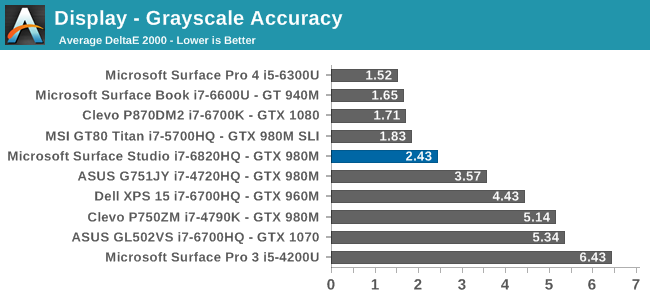
Microsoft nailed the gamma, which should be 2.2, and it very nearly is. However some errors creep up in the grayscale as the image gets closer to 100% white, with the red levels too high, and green a bit low. Overall, it’s still a very good average result, but not perfect. Notice how far they have come since the Surface Pro 3.
Saturation
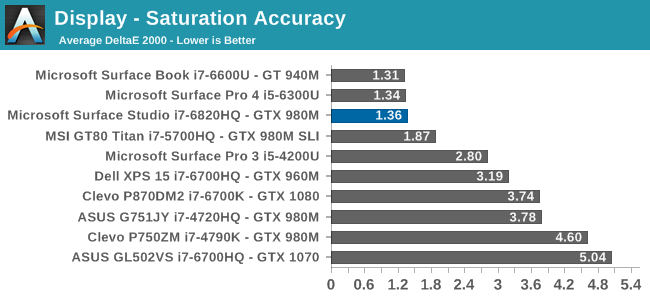
Once again, other than the white level errors at 100% white, the saturation result is fantastic. An overall error level of just 1.36 is very strong, and the individual color traces show that there are no real issues with any of the primary or secondary colors when set to sRGB.
Gretag Macbeth
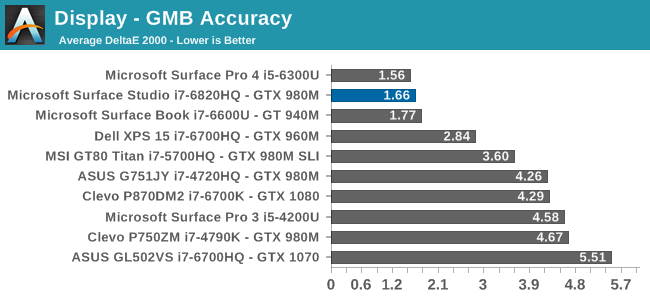
This test is the most comprehensive test, covering a large number of color points, including the important flesh tones. Here, again, the Surface Studio ends up with a fantastic result, and other than a single color, most of the errors are less than two, with many much closer to one. The sRGB results have started off very strong.
DCI-P3
Grayscale
When testing for the DCI-P3 color space, the gamma changes to 2.4, and the Surface Studio correctly hits this gamma as well. Across the entire grayscale sweep, the red, blue, and green levels are very consistent, and the average error level is just 1.27, which is outstanding. The display hits this new gamma and white point almost perfectly.
Saturation
Continuing its impressive results, the Surface Studio is practically perfect on the DCI-P3 saturation sweeps. The blue results and 100% white are the only real issues, but neither of them are really much of an issue at all.
Gretag Macbeth
An average error level under one is a great result again, and although there are a few individual colors that jump up to dE 2000 of three or so, almost every color tested is well under one.
Vivid (P3 D65)
Grayscale
The P3 D65 gamut moves back to a gamma of 2.2, and the Surface Studio nicely hits that. The error levels on the grays are all very low, with only 97.3% white jumping over the two line. The D65 white point is also almost perfect, with the red just a bit higher than it should be, but not to a level that would be very noticeable.
Saturation
The saturation graph is amazingly accurate. Only 20% yellow even crosses the one mark, outside of white and black.
Gretag Macbeth
Finally, the Gretag Macbeth test continues the trend of fantastic display calibration on the Surface Studio. Just a single color tested has an error level over three, with pretty much the rest of the tested colors showing an error level of under one. It is a pretty fantastic result.
Display Conclusions
It’s difficult to not be impressed by the work put into the Surface Studio’s display. Here we have a display with an ICC profile for sRGB, DCI-P3, and P3 D65, and in every gamut, the accuracy levels are near, if not the best, that have ever been tested on this site. It is a fantastic achievement, and a testament to what can happen if a company decides to focus on quality. There is no doubt that the Surface Studio’s display is the stand-out feature on this PC, and Microsoft has taken the time to individually calibrate each display to one of the highest levels of accuracy possible.
The fact that this display also features ten-point multitouch, and pen support, as well as having accuracy that is top-notch, makes the Surface Studio arguably the best computer display targeted towards consumers and prosumers. Combine that with the excellent 3:2 aspect ratio, the high pixel density, and practically perfect display scaling, and it would be hard to find any faults with this display. It truly is a masterpiece.


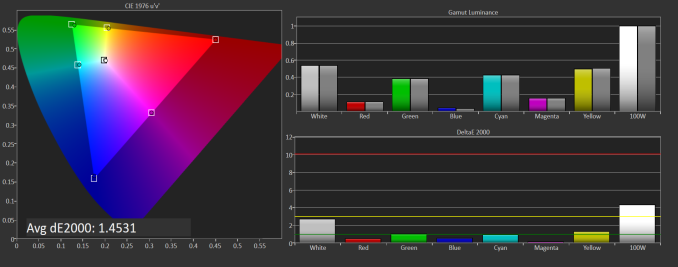
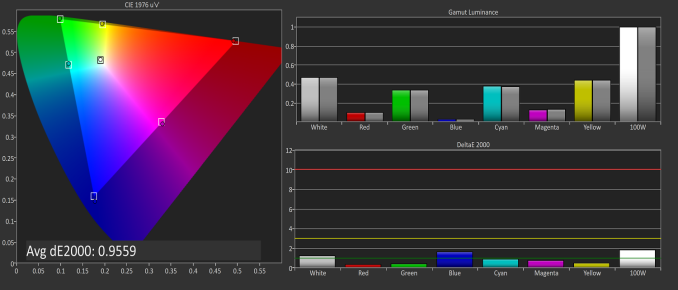

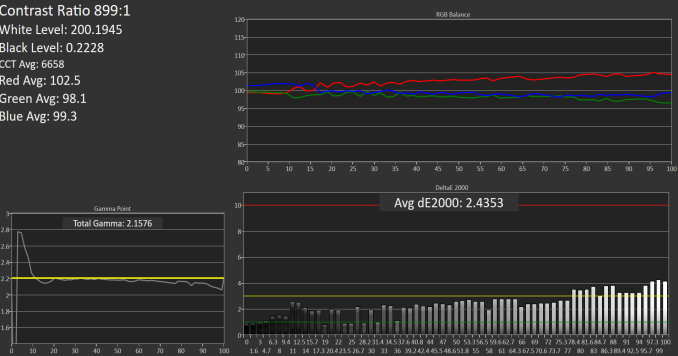
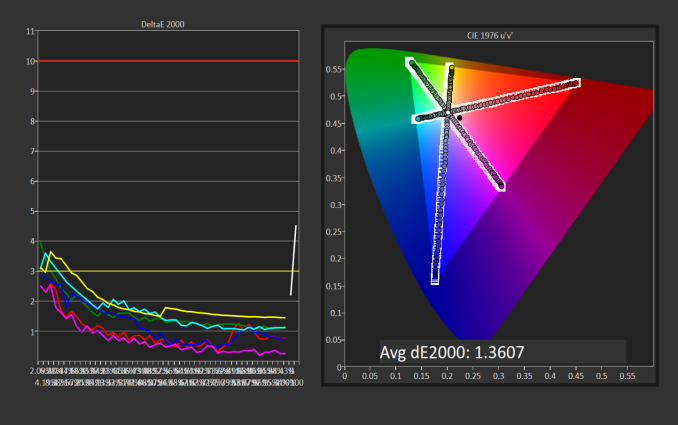

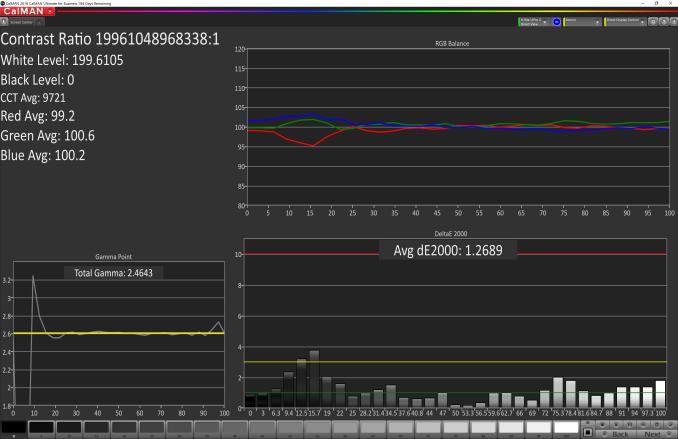
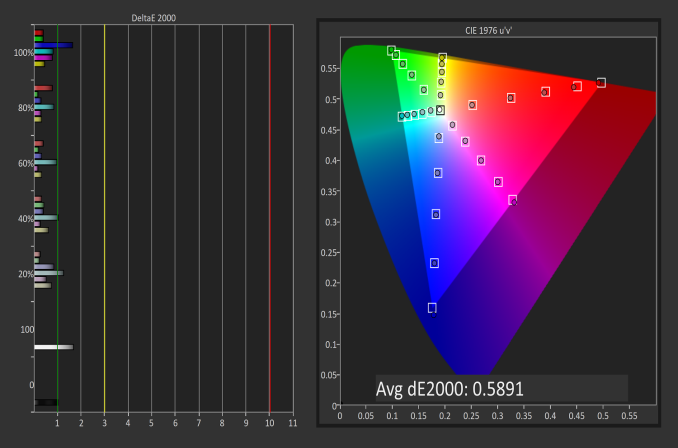
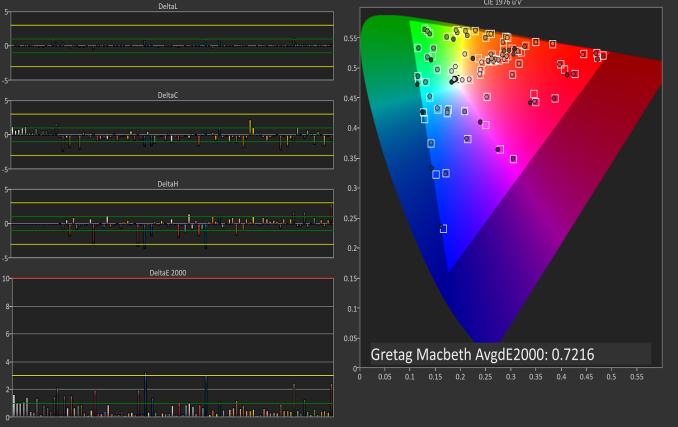

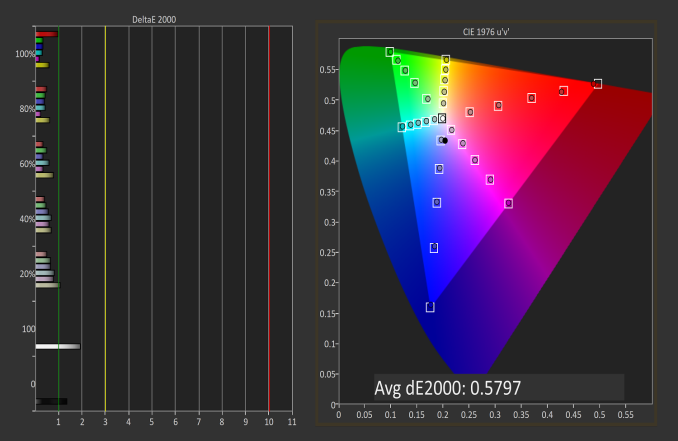
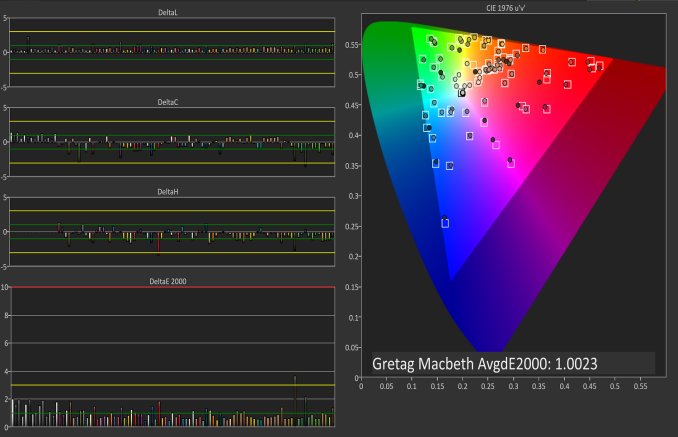








197 Comments
View All Comments
Valantar - Saturday, January 21, 2017 - link
"The most frustrating part of the Surface Studio base is that all the inputs and outputs are on the rear of the device, so connecting something over USB, or inserting a SD card into the PC, is not as simple as it should be. This is a form over function decision, and it would be nice to see some of the ports offered at least on the side of the base to make it a bit easier to access."Not quite form over function - the hinge mechanism and 20 degree angle would interfere with ports on all three sides (the hinges fold flat along the sides, and the display either touches the front or comes very, very close when folded all the way down. Cables, SD cards and the like sticking out would make this a hassle, and essentially break the functionality that is the core of this computer.
Brett Howse - Saturday, January 21, 2017 - link
Yes, it wouldn't work in the current design perfectly (although the SD card could easily be at the front) but regardless, having all of the ports on the rear makes it a chore to access them.Manch - Monday, January 23, 2017 - link
I saw that and thought a break out box would be nice. Of course that would make it less tidy, but having a bunch of cables run from around the backside worse.alkonaut - Saturday, January 21, 2017 - link
Is the motherboard and other hardware in the base, separate from the screen, meaning it could (at least in theory) be replaced while keeping the display?A display this good/expensive *has* to last at least 3 computers - so a definite no-go if it has to follow the motherboard/cpu/ram/ssd to the trash in 3 years!
Brett Howse - Saturday, January 21, 2017 - link
In theory, but unlikely this would ever be practicalManch - Monday, January 23, 2017 - link
I think we will see this with an upgraded base ala Surface Book. I doubt it will ever be user upgradeable which would be a nice. I don't know why people insist this will be in the trash in 3 years. Give it to me! If intels progress is any indication, you CPU will be good for a loooong time. Also for what this is designed for, I just don't see the applications out running the hardware anytime soon. With the Creators Update not out for a bit, I think they had enough time and should have went 1060/107 at least for the high end. Overall, a lust worthy machine. I don't need one, but damn I wouldn't mind having one.mobutu - Sunday, January 22, 2017 - link
I applaud the company for this obsessive attention to detail but what in the hell were they thinking fitting oldtech inside? thats just crazy and goes on the opposite spectrum of that obsessive attention to detail!-new cpu
-new gpu (lol, easily the BIGGEST mistake)
-ssd pcienvme only (I take a piss on their hybrid crap)
-in 2017, any computer should be dead silent while doing light workloads (browse, email etc). WTF they were thinking, designing this device with artists/creators in mind and giving them a noisy computer when they need SILENCE to be able to create properly!!!
-still big bezels on the otherwise wonderful display.
And LOL, ETA 6months for a GTX980??? thats gotta be a joke or something, when your "new" pc is arriving, that maxell is gonna be very ancient tech already, not just old!
As usual, wait for the next wave when they'll learn their lesson. Buying this now is kinda stupid.
mobutu - Sunday, January 22, 2017 - link
also, forgot about no usbc thinderbolt hdmi dp ... so connectivity also suffers in the curent implementationfanofanand - Monday, January 23, 2017 - link
Artists don't have a clue about anything you just wrote. They will just see the price tag and think "man this thing must be good" and will buy it. Do you really think the average artist knows the difference between a 965, a 980, and a 1080?nerd1 - Sunday, January 22, 2017 - link
So.. monitor is AWESOME and other parts are worse than $1500 laptop. Why doesn't they sell the monitor+touchscreen as a separate USB-C device, i.e. for $1500? I'd get one ASAP!